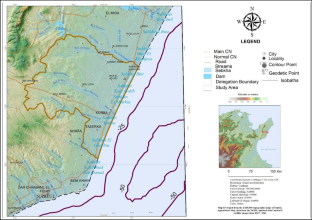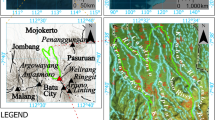Abstract
This study analyzed the spatiotemporal changes of the Korba coastline over 18 years using LANDSAT 5 and 7 and Sentinel 2A imagery. The research, focused on 2004–2022, used consistent spring tide conditions for image selection and processing. Following radiometric and geometric corrections, the LANDSAT imagery employed the normalized differential water index (NDWI) for land–water differentiation, while Sentinel 2A imagery used histogram-based pixel classification. Digital Shoreline Analysis System (DSAS) software validated the shoreline position changes. Using Earth Observation Point Reference (EPR) techniques, both regression and transgression in the study area were identified. In subsequent stages, comparisons were based on the 2004 topographic survey data and Landsat 7 imagery, emphasizing the consistent spring tide phase. Preliminary results from the study showcased minor variations in the coastal landscape, thus affirming the efficacy of high-resolution remote sensing methodologies for coastline monitoring. The synchronization of data acquisition with consistent tidal phases emerged as a crucial factor in ensuring the accuracy and reliability of the findings. This research not only contributes valuable insights into the spatiotemporal dynamics of the Korba coastline but also underscores the significance of methodological rigor in remote sensing applications along tidal phases for environmental monitoring.










Similar content being viewed by others
Data availability
The datasets used and analyzed during the current study are available from the corresponding author on reasonable request.
References
Al Mansoori S, Al Marzouqi F (2016) Coastline change mapping using a spectral band method and Sobel edge operator In: Huang B, López S, Wu Z, Nascimento JM, Li J, Strotov VV (eds). p. 100070P. https://doi.org/10.1117/12.2242046
Anzidei M, Antonioli F, Lambeck K, Benini A, Soussi M, Lakhdar R (2011) New insights on the relative sea level change during Holocene along the coasts of Tunisia and western Libya from archaeological and geomorphological markers. Quatern Int 232(1–2):5–12. https://doi.org/10.1016/j.quaint.2010.03.018
APAL (2000) Plan d’occupation de la plage de Korba, version finale
Baccar L, Moussa M, Ben-Hamza C (2001) Conservation des zones humides littorales et des écosystèmes côtiers du Cap-Bon. L’hydraulique des zones humides de Maamoura, Tazarka et Korba
Bardi I, Abdeljaouad S, Souayed M (2011) Evolution du trait de côte de Gabès-Oued Ferd (SE de la Tunisie). Edition 2, Tanger, Maroc, pp 129–132. https://doi.org/10.5150/cmcm.2011.027
Bilal M, Nazeer M, Nichol JE, Bleiweiss MP, Qiu Z, Jäkel E, Campbell JR, Atique L, Huang X, Lolli S (2019) A Simplified and robust surface reflectance estimation method (SREM) for use over diverse land surfaces using multi-sensor data. Remote Sens 11(11):1344. https://doi.org/10.3390/rs11111344
Boak EH, Turner IL (2005) Shoreline definition and detection: a review. J Coast Res 214:688–703. https://doi.org/10.2112/03-0071.1
Bouchahma M, Yan W (2014) Monitoring shoreline change on Djerba Island using GIS and multi-temporal satellite data. Arab J Geosci 7(9):3705–3713. https://doi.org/10.1007/s12517-013-1052-9
Boussetta A, Niculescu S, Bengoufa S, Zagrarni MF (2022) Spatio-temporal analysis of shoreline changes and erosion risk assessment along Jerba island (Tunisia) based on remote-sensing data and geospatial tools. Region Stud Mar Sci 55:102564. https://doi.org/10.1016/j.rsma.2022.102564
Burollet PF (1991) Structures and tectonics of Tunisia. Tectonophysics 195(2–4):359–369. https://doi.org/10.1016/0040-1951(91)90221-D
Chen F, Guo H, Tapete D, Cigna F, Piro S, Lasaponara R, Masini N (2022) The role of imaging radar in cultural heritage: from technologies to applications. Int J Appl Earth Obs Geoinf 112:102907. https://doi.org/10.1016/j.jag.2022.102907
EROS, Earth Resources Observation and Science Center (2015) Landsat surface reflectance data [Fact Sheet].
Genz AS, Fletcher CH, Dunn RA, Frazer LN, Rooney JJ (2007) The predictive accuracy of shoreline change rate methods and alongshore beach variation on Maui, Hawaii. J Coast Res 231:87–105. https://doi.org/10.2112/05-0521.1
Halouani N, Sabatier F, Gueddari M, Fleury J (2007) Évolution du trait de côte de Tabarka-Bouterfess, nord-ouest de la Tunisie. Méditerranée 108:131–137. https://doi.org/10.4000/mediterranee.192
Halouani N, Fathallah S, Gueddari M (2012) Beach and nearshore morphodynamic changes of the Tabarka coast, Northwest of Tunisia. Environ Earth Sci 66(4):1059–1069. https://doi.org/10.1007/s12665-011-1312-5
Halouani N, Gueddari M, Frihy O (2013) The Northwestern Mediterranean Coast of Tunisia: wave processes, shoreline stability and management implications. Arab J Sci Eng 38(7):1851–1860. https://doi.org/10.1007/s13369-012-0401-4
Hesp P (2002) Foredunes and blowouts: initiation, geomorphology and dynamics. Geomorphology 48(1–3):245–268. https://doi.org/10.1016/S0169-555X(02)00184-8
Himmelstoss E, Rachel EH, Meredith GK, Amy SF (2018) Digital shoreline analysis system (DSAS) version 5.0 user guide [open-file report]
Karaman M (2021) Comparison of thresholding methods for shoreline extraction from Sentinel-2 and Landsat-8 imagery: extreme Lake Salda, track of Mars on Earth. J Environ Manag 298:113481. https://doi.org/10.1016/j.jenvman.2021.113481
Kılar H (2023) Shoreline change assessment using DSAS technique: a case study on the coast of Meriç Delta (NW Türkiye). Region Stud Mar Sci 57:102737. https://doi.org/10.1016/j.rsma.2022.102737
Kuleli T, Guneroglu A, Karsli F, Dihkan M (2011) Automatic detection of shoreline change on coastal Ramsar wetlands of Turkey. Ocean Eng 38(10):1141–1149. https://doi.org/10.1016/j.oceaneng.2011.05.006. (Article 10)
LCHF (1979) Action de la houle sur les sédiments. Rapport pour le C.N.E.X.O.
Louati M, Zargouni F (2013) Le littoral entre l’actuelle embouchure de l’oued Miliane et Soliman, Tunisie. Analyse de l’évolution du trait de côte par photo-interprétation et système d’information géographique. Géomorphologie: Relief, Processus, Environnement 19(2):209–224. https://doi.org/10.4000/geomorphologie.10257
Louati M, Saïdi H, Zargouni F (2015) Shoreline change assessment using remote sensing and GIS techniques: a case study of the Medjerda delta coast, Tunisia. Arab J Geosci 8(6):4239–4255. https://doi.org/10.1007/s12517-014-1472-1
Maiti S, Bhattacharya AK (2009) Shoreline change analysis and its application to prediction: a remote sensing and statistics based approach. Mar Geol 257(1–4):11–23. https://doi.org/10.1016/j.margeo.2008.10.006
Nazeer M, Waqas M, Shahzad MI, Zia I, Wu W (2020) Coastline vulnerability assessment through landsat and Cubesats in a Coastal Mega City. Remote Sensing 12(5):749. https://doi.org/10.3390/rs12050749
Neumann B, Vafeidis AT, Zimmermann J, Nicholls RJ (2015) Future coastal population growth and exposure to sea-level rise and coastal flooding. A global assessment. PLoS ONE 10(3):e0118571. https://doi.org/10.1371/journal.pone.0118571
Nicholls RJ, Cazenave A (2010) Sea-level rise and its impact on coastal zones. Science 328(5985):1517–2150. https://doi.org/10.1126/science.1185782. (Article 5985)
Saïdi H, Zargouni F (2019) Sea-level rise impact on the evolution of a microtidal Mediterranean coastline without human-made structures—a case of the Port aux Princes-Sidi Daoued coastline, Gulf of Tunis, NE-Tunisia. Acta Oceanol Sin 38(3):72–77. https://doi.org/10.1007/s13131-018-1331-0. (Article 3)
Saïdi H, Souissi R, Zargouni F (2012) Impact of shore-parallel breakwaters on the microtidal coast of Hammam-Lif (North-East of Tunisia). Arab J Geosci 5(2):345–352. https://doi.org/10.1007/s12517-010-0223-1
Saïdi H, Souissi R, Louati M, Zargouni F (2014) Morphologic changes and sedimentary budgets along a Mediterranean coastline with a sand spit: case of the littoral fringe Sidi Ali El Mekki-Gammarth (NE Tunisia). Rendiconti Lincei 25(3):393–401. https://doi.org/10.1007/s12210-014-0314-0
Saïdi H, Louati M, Jaballi Z, Ghraidi L (2022) Coastal morphology changes in the southern Mediterranean Basin: the case of the Hammamet fringe (Gulf of Hammamet, NE-Tunisia). J Coast Conserv 26(6):59. https://doi.org/10.1007/s11852-022-00904-0
Thoai DT, Dang AN, Kim ON (2019) Analysis of coastline change in relation to meteorological conditions and human activities in Ca mau cape, Viet Nam. Ocean Coast Manag 171:56–65. https://doi.org/10.1016/j.ocecoaman.2019.01.007
Thomas GA, Santha R, Jeyagopal S, Thodhal YS (2023) Statistical analysis of shoreline change reveals erosion and baseline are increasing off the northern Tamil Nadu Coasts of India. Environ Monit Assess 195(3):409. https://doi.org/10.1007/s10661-023-11015-0
Williams AT, Rangel-Buitrago N, Pranzini E, Anfuso G (2018) The management of coastal erosion. Ocean Coast Manag 156:4–20. https://doi.org/10.1016/j.ocecoaman.2017.03.022
Yahyaoui Z, Rebaï N (2014) Etude de l’évolution morphosédimentaire à court et moyen terme du système dune/plage de Korba (façade orientale du Cap Bon, Tunisie). Revue Internationale De Géomatique 24(4):471–500. https://doi.org/10.3166/rig.24.471-500
Yahyaoui Z (2016) Modélisation spatio-temporelle de l’évolution morpho-sédimentaire d’une plage microtidale à deux barres: Cas de la plage de Korba, façade orientale de la Tunisie, Cap Bon. Thèse docteur en géologie
Yamano H, Shimazaki H, Matsunaga T, Ishoda A, McClennen C, Yokoki H, Fujita K, Osawa Y, Kayanne H (2006) Evaluation of various satellite sensors for waterline extraction in a coral reef environment: Majuro Atoll, Marshall Islands. Geomorphology 82(3–4):398–411. https://doi.org/10.1016/j.geomorph.2006.06.003
Zâara Ch (1996) Étude de la stabilité du littoral du golfe de Hammamet. Impact de la dynamique sédimentaire sur la morphologie côtière. Mémoire de fin d’étude
Acknowledgements
I would like to extend my heartfelt gratitude to all those who contributed to the success of this study. Firstly, to the entire research team, whose diligence, expertise, and unwavering commitment were invaluable. I am particularly thankful to the local communities of Korba, who generously shared their insights and experiences, grounding our research in the realities of the coastline they call home. The contributions from the technical staff, who ensured the seamless processing and analysis of the remote sensing data, deserve special mention. Furthermore, the authors would like to mention that the maps used in this research (which were prepared by the authors) are based on Open Street Maps, USGS data, and official regional data. Finally yet importantly, I am grateful to our peers who provided critical reviews and constructive feedback at various stages of the research.
Funding
No funds, grants, or other support was received.
Author information
Authors and Affiliations
Corresponding author
Ethics declarations
Conflict of interest
The authors declare no conflict of interest. The authors declare they have no financial interests.
Additional information
Responsible Editor: Mohamed Ksibi.
Rights and permissions
Springer Nature or its licensor (e.g. a society or other partner) holds exclusive rights to this article under a publishing agreement with the author(s) or other rightsholder(s); author self-archiving of the accepted manuscript version of this article is solely governed by the terms of such publishing agreement and applicable law.
About this article
Cite this article
Noamen, R., Rihem, M.E., Zouhour, Y. et al. Diachronic study of coastline behavior using remote sensing: a case study of Korba beach, Tunis. Euro-Mediterr J Environ Integr 9, 1033–1049 (2024). https://doi.org/10.1007/s41207-024-00478-3
Received:
Accepted:
Published:
Issue Date:
DOI: https://doi.org/10.1007/s41207-024-00478-3




